Hello dear readers! I hope you all enjoyed the more abstract
post about matching the characters into effective duets! Today we’re going to
have another one of the abstract strategy posts with a little twist – a guest
writer! As I had mentioned before, I’ve been facing the unspeakable horrors not
alone, but with my loyal wife at my side. She is also heavily fascinated with
the occult knowledge of Arkham Horror: The Card Game. We have discussed game
and my posts together in the past – now she decided to go one step further and
co-write a post with me.
We’d like to thank the Polish Arkham Horror community. Lots
of the post’s content, as well as the general idea behind it, were inspired by
great discussions we’re having there.
The topic we’d like to bring to your attention this time is
risk management. Arkham Horror is a game with a pretty heavy luck element. Therefore,
an appropriate approach to the luck-related mechanics is a key to every
successful world saving mission. Particularly the part we call “Risk Management”.
By this term we mean taking calculated risks, screwing the odds in player’s
favor and balancing multiple, mutually exclusive/competitive luck-related goals.
There are two main areas of risk management we’d like to
talk about today. The first one if related to the skill tests and the Chaos
Bag. The second one involves deck building, particularly the redundancy.
Let me start with the Chaos Bag.1 I have done
some calculations (though it gets really fancy and math-heavy in the next part,
just wait for it). Below you can find two tables, the first one is bit tough to
read, as it contains chances of succeeding in multiple scenarios (they differ
by the modifiers of the symbol tokens)2
Since it is not very easy to decipher, I have also done some
averaging, to make some more general observations.
We can draw some general conclusions based on the gathered
data. First of all, not each committed icon is equal. Icons that raise our
skill value to +2 and +3 have the biggest impact on the pass chance. The
average suggests, raising from +1 to +2 yields the most benefit, statistically.
The details depend on the modifiers of the symbol tokens, though. If some (or
all) tokens only result in -1 modifier, raising your skill to +1 can also help
a lot. So please bear it in mind in order to make an educated choice.
Furthermore, another very strong (and applicable in
virtually every situation) conclusion can be drawn. If you have two skill
checks, two icons/resources to commit and plan/have to succeed in both,
committing one to each is vastly superior. For instance, on average the
difference is of over 10 percentage points (19 to 30 when comparing to +2’s to
+1 and +3's). Same logic applies to spending 4 resources (split of 2 each makes
the most sense).
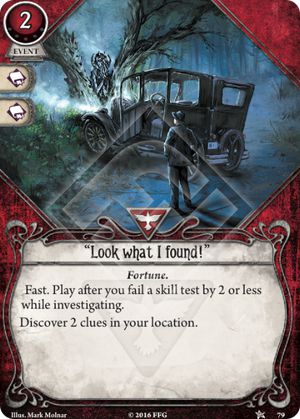 |
| There are occasions when you don't mind failing |
Sometimes pumping the test up to +4 (or even higher should any of the symbol tokens provide a higher modifier)
obviously makes sense. If failing means a certain scenario failure/death you
might consider maximizing your odds. If you have an abundance of resources
hoarding them might also be suboptimal. If you’re about to finish the scenario,
having spare cards/resources is also not going to help you. There are also other
scenarios, like committing “Double or Nothing” (or any Vicious Blow – like
card) or attempting a success by two or more (basically use two icons more for
the same probability result).
The table can also be used to determine some special cases.
The first one is Wendy’s redraw ability. We can use it to check her combined
chance of succeeding in a test, either at the first attempt, or a redraw. Almost
exactly the same chances apply to the Grotesque Statue, with an important
exception – we draw 2 tokens simultaneously – it increases the chances slightly
(most importantly can give you a shot at 100% sure draw. Similarly, unless you
have any symbol token with -4 or lower modifiers being at +3 all but guarantees
a successes). I am using averaged values again and again with the same
disclaimer – pay extra attention to the values of symbol tokens.
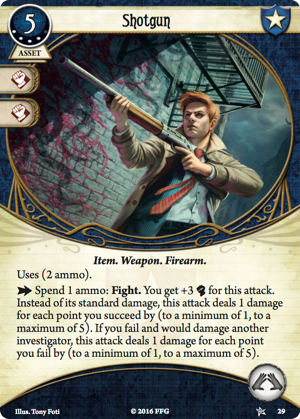 |
| On other occasions you have to succeed, ideally by 5. |
Analysis provides us with few notions. Unsurprisingly, the
less chances at passing we have, the more (in percentage, not the percentage points)
are they boosted by a redraw. We can put the chart for a better use, than just
satisfying our curiosity – we can answer a following dilemma – is it better to
commit a card for an icon, or keep it for a redraw? At -1 and 0 the answer is
obvious – boosting our skill is a superior choice. Quite the other way around
with +2 and higher – keeping a card for a potential redraw should be our best
bet. More of a controversial point lies within +1. On average your chances are
maxed by a redraw. However, this is just an average case – I can easily find
scenarios, where the opposite is true. Hence, once again my advice – check the
symbol tokens values – whenever you have a majority of “-2s”, you should go
with a boost…
…or shouldn’t you? You must always bear in mind, maximizing
the odds of succeeding a single test is only one side of the coin. Each time
you gamble on redrawing, you might succeed the first time, effectively saving
the card. Final choice should therefore include more factors than just
maximizing your chances – you should also take the test’s importance and your card
pool into account.
There is one more point, I’d like to raise about chaos
tokens – Jim’s ability. As you could have learned from my review, I am a
fan of this investigator. Still, his special ability is rather a situational
one. How? It does only come in handy, if our modifier is below the skull’s modifier. Otherwise we would have succeeded the
test, drawing the skull regardless of using his ability. Therefore to squeeze
as much as you can from his ability (keeping it unused puts you at a
disadvantage, as you’re basically playing with no ability) you must attempt
test regularly at a lower skill value.
I hope you find above points useful and not too complicated.
The really complex math starts below, however don’t be too afraid – we’ve
already done the most difficult part for you (and we actually enjoyed it,
probability is one of the most fun [if not the funniest!] areas of mathematics!).
In order to be successful in your journey through countless
horrors and terrors of the Lovecraft's world, you need to create a well-balanced
and efficient deck. Many factors need to be considered while creating a deck.
Since this post is about risk management, I will focus on the redundancy.
Before I delve into details, first let's remind us the general requirements of
creating a (typical) deck.
1.
A deck must consist of exactly 33 cards.
2.
You can choose only 30 of them. The other three are character's
signature card, character's personal weakness and a random basic weakness.
3.
You can include only up to two copies of the
same card (card with the same name)
4.
Investigator's unique deck building requirements,
which precisely specify pool of available cards for the investigator.
While creating a deck you also need to keep in mind that you
start the game with a hand of five cards drawn from the deck. And to be
precise, these are five cards out of 31, not the original 33, as both of your weaknesses don't
matter (you simply discard and shuffle them back into the deck if drawn). On top of that, you can mulligan your hand once. You
need to keep the second hand – no matter if you like it better than the previous
one or not. That's it when it comes to rules.
As mentioned before, in this post I'm going to focus on the redundancy. By redundancy I
mean a duplication of critical card(s) with the intention of increasing reliability of the deck.
 |
| So many cards to choose from. And you also have to decide how many copies of them... |
What differs AH:TCG from other card games, are limited slots for playing
your cards (for
example, there is only
one ally slot), which often makes drawing additional copies of the same card less useful. Still we need to include them, just to
increase our chances of drawing a particular card. The slot limitation is not
the only drawback of having too many copies of the same card. Quite often playing another copy of the same card yields no additional profit. For instance, you have two
hand slots and theoretically could play 2 Machetes, but it won't make you any
better of a fighter.4
It is crucial to find a sweet spot between having too few
copies of the same card (which could result in not drawing it at all, thus
making your character far less efficient) and having too many (which would make
you commit them for icons only, a
clearly inferior use of the card). I made some calculations to get the chances of drawing a
particular card in your opening hand, depending on how many copies of the card
you have. Please note, all cards
that fill the same role
in your deck are effectively a copy of the same card. For example – different weapons can be perceived as the same
card, since they serve the same purpose. Other example are evading card for characters focused on evading, or
assets boosting a particular skill.
TABLE 1
CHANCES OF DRAWING AT LEAST ONE COPY OF
A GIVEN CARD ON YOUR
OPENING HAND
1 copy 16 %
2 copies 30 %
3 copies 42%
4 copies 52.5 %
5 copies 61.5 %
6 copies 68 %
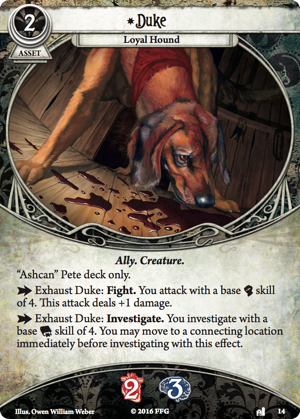 |
| This little fella luckily doesn't have to be drawn. |
TABLE 2
CHANCES OF DRAWING
AT LEAST ONE COPY OF A GIVEN CARD WITHIN 10 FIRST CARDS (EITHER IN THE
OPENING HAND OR AFTER A MULLIGAN ASSUMING YOU DREW NONE IN YOUR FIRST
HAND)
1 copy 32.5%
2 copies 55%
3 copies 70.5%
4 copies 81%
5 copies 88%
6 copies 92.5%
Analyzing these numbers you can clearly see,
a sweet spot lies between four
and five copies of the
same card. With four copies
you already have a quite decent chance of drawing your card. Fifth copy increases it
to an even higher level, making you significantly less luck dependent. Having six
copies, however, seems
to be already overkill. The difference between having five and six copies is not big. Five copies provide you already
with a very high chance of succeeding. Adding one additional copy doesn't help
that much, yet blocks
your deck slot which
could be used for another card.
Table 2 alone is
very useful if your strategy
is based on a hard mulligan (you always mulligan if the required card is not
present on your opening hand. You never mulligan, if it is). In such situation
you can clearly see your chances and decide how much of a risk are you willing
to take. Note, that in a long campaign you will be taking such a risk at the beginning
of each scenario.
The above reasoning
applies only to the cards that can be added in the deck in more than two copy
(cards that don't have the same name but serve the same purpose). But there are quite a few
cards that are unique and you won't find another one of
the same kind. That leaves you
with a possibility of having up to two copies of this card in a deck. Unfortunately a chance of
drawing such a card in
either your first hand second hand is not really
good. If such a card is a crucial element of your deck – it puts you in a tough
situation.
 |
| My favorite deck digging card. |
There are two ways of mitigating the risk of not drawing
your key card within 10 first cards – having a card drawing/card searching
options in your deck or having a backup plan.
First strategy is simple – you add cards that let you draw
cards from your deck or look for a specific card (Old Book of Lore, Stand Together, Flare). This way you have a decent
chance or getting either your key card on the opening hand already, or of
getting at least one of these 'drawing' cards (which in result will help you
get your key card). „Plan B”
strategy requires taking in your deck cards that won't make a 'machine' work
any better, but that can help you to do your job quite efficiently even if you
don't manage to get your key card. These cards should be chosen carefully -
they need to be flexible and usable both together with 'plan A' and without.
If hard mulligan isn't your way, you might need few more
numbers to decide when it's worth to draw a second hand and when the risk is too high. That's why I prepared
another table – table 3 – which depicts the chances of drawing one of your key cards after a mulligan, in case of having
drawn exactly one copy in
your opening hand:
TABLE 3
CHANCES OF DRAWING
A GIVEN CARD
AFTER A MULLIGAN
IF YOU HAVE ONE COPY ON YOUR OPENING HAND
IF YOU HAVE ONE COPY ON YOUR OPENING HAND
1 copy 0% (SURPRISE!)
2 copies 19%
3 copies 32.5%
4 copies 49%
5 copies 60%
6 copies 69%
With these numbers, the perspective of what is a sweet spot might change. Four copies of the same card,
that seemed to be good enough in a hard mulligan strategy, might not be good
enough if you want to be more flexible. If you have four copies of a card in
your deck and you drew one of
them in your opening hand, that is overall weak, you're in a quite tough situation. You can
either keep the hand to ensure
having one of the key cards or decide to mulligan in hope of getting a stronger hand. The second alternative puts
you at risk of not drawing any of key cards (roughly a
fifty-fifty split). We can also reverse the situation – what if you
didn't get the most needed card, but all five cards in your hand are strong? You can keep the hand, reliably hoping to get
of the needed cards soon (see later in the table 4).
When you
need to make this decision you should keep in mind that you already have some
strong cards on your hand and discarding them now would put you on risk of not
drawing them any time soon (assuming you have only two copies of most of your
cards your chances of drawing the other copy on next five cards is really low).
You need to be aware that if you go for a mulligan in such scenario, you
risk having a hand full of less useful cards. Depending on how many copies of a
key card you have in
your deck, you can easily end up without your crucial card and overall weaker hand.
Maybe it
would be good to see your chances of drawing your key card (or any other card
you care about) on next four cards drawn from your deck during the game (depending
on number of copies you have, based
on the assumption you got none originally)
TABLE 4
CHANCES OF DRAWING
A PARTICULAR CARD
ON NEXT 4 CARDS FROM YOUR DECK
1 copy 15%
2 copies 28%
3 copies 39.5%
4 copies 49.5%
5 copie 58.5%
6 copies 66%
First let's analyze these numbers in relation to table 2.
Having four copies
gives you first 81 % chances of drawing it on your opening hand (hard mulligan
option). Next, if you
were unlucky, you have almost 50 % chances of getting it on next four cards drawn from your
deck. All together you would have to be rather unlucky not to get it quite
early in the game. If
you can manage without it, the
risk might pay off, since chances of getting it soon are not bad. Even higher if you have any
drawing mechanisms or just spend actions getting more cards.
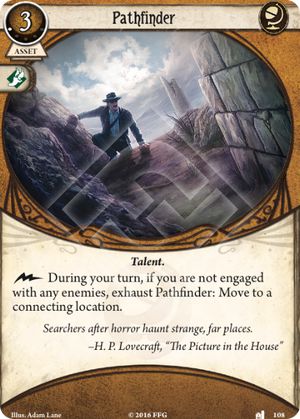 |
| Getting two Pathfinders and no weapon in opening hand? Tough luck! |
I wouldn't recommend having less then four copies if the card is truly crucial
for your strategy. Your chances drop significantly if you remove one copy.
Having five is a good
choice for people who don't want to risk and for these who value flexibility. It comes at a cost of having one
less slot for other cards, though, leading to removing submarginal cards from
the deck.
I would
also like to bring your attention to one more vital factor of redundancy. I
focused so far on drawing at least one of the copies of your key card on your
hand and assumed that having one only is good enough. But is it really? There
are some mechanics in the game that force you to discard cards, both the assets
you have already in play or cards you keep in your hand. It's tough to protect
against such effects (Ward of Protection is the best solution if the effect
comes from encounter deck). This way you can easily lose your precious card and
be left with effectively one less copy in the deck. Wouldn't it be
better to have more copies in your opening hand in the end? Or at least more copies to draw a replacement
soon enough? For sure it is at least worth consideration. You need to decide if you prefer to
have this backup copy and be ready for such events or rather take some risks (as pointed out already – additional
copy of the same card usually doesn't give you any additional value, can be only committed for icons
to the test).
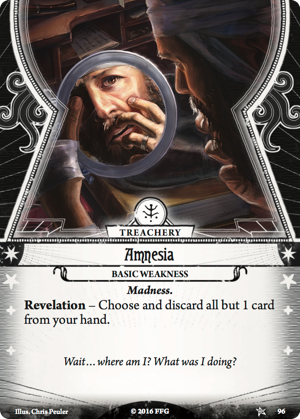 |
| Even your own card can easily hurt your hand, depriving you of key assets. |
This are
still not all the factors you need to consider while deciding on number of
copies. There is one more aspect, which can't be easily dismissed (even if it probably won't
impact your judgment too strongly). The game (its campaign version, to be exact) sometimes
provides you with an option to add a new card to your
deck. This card doesn't count towards the investigator's deck size limit. It is entirely plausible, that
during a long campaign your deck will grow in size, while the amount of copies of your key card
remains the same. This impacts all numbers presented in my tables – the chances of getting the key card are
getting lower, obviously. Although
in a case of adding just one
card, it doesn't make a big difference (below two percentage points) and probably won't impact your
decision. The situation
changes with addition of
more cards. With three
more cards in your deck the difference in chances of drawing a particular card
is around four percentage
points (almost 8% of the original value!) already. In case of having four copies in your deck,
your chances suddenly drop from over 50% (52, exactly) to below 50% (48) – meaning you
rather WON'T, than will,
get your card.
Let me summarize:
1.
Having between four and five copies gives you the most balances of drawing a crucial card
early in the game
2.
Having
four copies is a better choice for hard mulligan players
3.
Taking
five copies gives more flexibility
4.
The more campaign cards you take into your deck
the more the chances drop moving the sweet spot towards five copies.
I strongly
believe, having four and five copies of the card are both good choices, particularly in case of assets. If
for some reasons you are basing your deck on events, more copies will for sure
be needed. The calculation is not as straight forward anymore and delves too
deep (pun intended) into the realm of speculations. The opinion about
which one is better will vary between investigators and (most importantly) players, depending mostly on their playing
style. The most important things to consider while making an educated choice are:
–
How crucial is the card for your strategy?
–
Can
you manage without it?
–
Can
other players handle your area if you don't get it?
–
How long is the campaign (you will be taking the risk of not
drawing your card at the beginning of each scenario)
–
Are there other means of getting your card?
(other investigators or
yourself having any card
drawing options)
A related,
yet somehow separate topic are the “combo decks”5. One could
consider creating a deck that strongly
relies on two particular cards working together. A strong combination of
two cards to achieve an exceptionally good effect might be tempting, but let's see how it looks with
numbers.
I made an assumption that your combo is based on two cards you have in two copies only. The chances you
will draw both of them in your opening hand are around 7.5 % - definitely not good enough to
create the whole deck around it and to rely only on this one combo. You can
increase the chance up to 10.5
% in your second hand, but only assuming you didn't draw any of them on your
first hand (and there is not even 50% chance for such a scenario). Not only the chances of getting the combo in your hand are
low even including mulligan option, but also the chance that it will be worth
to mulligan is not impressing (only
when you drew none of them on the first hand).
 |
| Good synergy with Emergency Aid, but don't plan your whole deck around it. |
If you draw precisely
one of your cards in the
opening hand (31.5 % of chance), for sure you shouldn't risk mulligan
– you have over 50% chance of
drawing none of them on your second hand! If a mulligan is not a good option
it means you are forced to play with one card of your combo only and hope to get the other card soon. The chances of getting a key card on
the next 4 cards drawn during the game (assuming you have two copies) are 28% only
(table 4).
With such numbers an idea of combo deck based on combining
two particular cards doesn't seem reasonable. Some combos are possible, but you
shouldn't rely only on them. If you really want to include cards that make a
nice combo in your deck, you need to think how to make it work in more combination than 2 particular cards
only.
Let's take Rex
and Scavenging as an example – you need an item you can keep committing
and getting back with Scavenging.
Scavenging without this item will be next to useless. But don't include only
one item for this purpose (even in two copies it won't be enough) – take Rabbit’s Foot, Flashlight, Strange Solution (all in two copies)
and any other card you can think of. This way not only the chance of making the mechanism work grows significantly, but also you can put some of these cards with
their original use – play
them as an asset and use only another item for committing purposes.
Even in a
deck created this way there is still a problem with
Scavenging itself– there's no other card you can take that would work
similarly to it.
Therefore you can have
maximum two copies of
this card in your deck. How to
deal with this problem has been already described earlier – two ways of
mitigating the risk of not getting your key card (under table 2).
We hope you
found our analysis interesting and useful in your everyday gaming! Let us know
if you agree with the conclusions and see you all in Dunwich!
1Please note all the calculations are made for
the standard difficulty. Some of the points that I’m raising do also apply to
other difficulty levels.
2For the purpose of simplicity I assumed Elder
Sign to be equal to “0”. It doesn’t change the results too heavily for
investigators with positive ES values. One does very rarely make skill checks
with negative base value anyway.
3 I like to use a small trick when calculating
the odds – it’s much simpler to get the chances of failing. Just a trivia if anyone of you is willing to do some of related math on his own.
4In most of the card games multiple copies of the
same card can be successfully used. However FFG seem to build many of the games
around making multiple cards unique, which enhances the deckbuilding
experience. The committing mechanic is a brilliant way to balance it out for
AH:TCG.
5If we stick to the Magic: the Gathering
terminology I’ve been using every now and then, one can hardly imagine a pure “combo
deck” in Arkham. Classic combo deck either pulls out the combo and wins, or
fails to do it before it gets overrun and loses. This doesn’t happen yet in
AH:TCG and I kinda can’t imagine such a possibility. The term is used here to
indicate decks highly relying on such a combination, key synergy.


I'm not sure if I'm misunderstanding, but you seem to think your mulligan is all or nothing. In fact, you can keep any cards from your opening five, then draw up to 5.
ReplyDeleteI can't believe we've been misplaying the rules so much! It does make the game so much easier!
DeleteUnfortunately it renders lots of calculations useless.
Was gonna comment the same thing. :D But I played the mulligan rules in another wrong way for my first few games too.
DeleteThat aside, I just caught up with your blog and am enjoying it very much!
Thank you Dragnipurake for the kind words!
DeleteI am posting new stuff on weekly basis, mostly on Sundays. Hope you enjoyed the new article about BotA cards ; )
I want to thank Dr Emu a very powerful spell caster who help me to bring my husband back to me, few month ago i have a serious problem with my husband, to the extend that he left the house, and he started dating another woman and he stayed with the woman, i tried all i can to bring him back, but all my effort was useless until the day my friend came to my house and i told her every thing that had happened between me and my husband, then she told me of a powerful spell caster who help her when she was in the same problem I then contact Dr Emu and told him every thing and he told me not to worry my self again that my husband will come back to me after he has cast a spell on him, i thought it was a joke, after he had finish casting the spell, he told me that he had just finish casting the spell, to my greatest surprise within 48 hours, my husband really came back begging me to forgive him, if you need his help you can contact him with via email: Emutemple@gmail.com or add him up on his whatsapp +2347012841542 is willing to help any body that need his help.
Delete